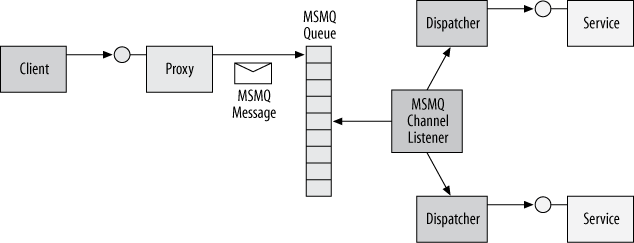Queued Calls
WCF provides support for queued calls using the NetMsmqBinding. With
this binding, instead of transporting the messages over TCP, HTTP, or
IPC, WCF transports the messages over MSMQ. WCF packages each SOAP
message into an MSMQ message and posts it to a designated queue. Note
that there is no direct mapping of WCF messages to MSMQ messages, just
like there is no direct mapping of WCF messages to TCP packets. A single
MSMQ message can contain multiple WCF messages, or just a single one,
according to the contract session mode (as discussed at length later).
In effect, instead of sending the WCF message to a live service, the
client posts the message to an MSMQ queue. All that the client sees and
interacts with is the queue, not a service endpoint. As a result, the
calls are inherently asynchronous (because they will execute later, when
the service processes the messages) and disconnected (because the
service or client may interact with local queues).
Queued Calls Architecture
As with every WCF service, in the case of a queued service the client interacts with a proxy, as shown in Figure 9-2.

Figure 9-2. Queued calls architecture
However, since the proxy is configured to use the MSMQ binding, it does not send the WCF message to any particular service. Instead, it converts the call (or calls) to an MSMQ message (or messages) and posts it to the queue specified in the endpoint’s ...